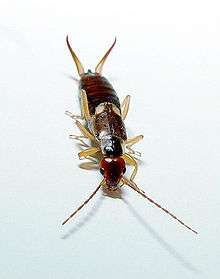Forficulidae
Forficulidae is a family of earwigs in the order Dermaptera. There are more than 70 genera and 490 described species in Forficulidae.[1][2][3][4][5][6]
| Forficulidae | |
|---|---|
 | |
| Forficula auricularia | |
| Scientific classification | |
| Kingdom: | Animalia |
| Phylum: | Arthropoda |
| Class: | Insecta |
| Order: | Dermaptera |
| Suborder: | Neodermaptera |
| Infraorder: | Epidermaptera |
| Superfamily: | Forficuloidea |
| Family: | Forficulidae Latreille, 1810 |
| Subfamilies | |
| |
Species in this family include Forficula auricularia (the European earwig or common earwig) and Apterygida media (the short-winged earwig or hop-garden earwig).
Forficulidae was formerly considered a suborder of Dermaptera, Forficulina, but was reduced in rank to family and placed in suborder Neodermaptera.[4][6]
.jpg)
Timomenus komarovi
Genera
These 71 genera belong to the family Forficulidae:
- Acanthocordax Günther, 1929
- Afrocosmia Hincks, 1960
- Afroforficula Steinmann, 1990
- Allodahlia Verhoeff, 1902
- Ancistrogaster Stal, 1855
- Anechura Scudder, 1876
- Apterygida Westwood, 1840
- Arthroedetus Caudell, 1907
- Brachycosmiella Steinmann, 1990
- Brindleiana Steinmann, 1975
- Chaetocosmia Nishikawa, 1973
- Chamaipites Burr, 1907
- Chelidura Latreille, 1825
- Cipex Burr, 1910
- Cordax Burr, 1910
- Cosmiella Verhoeff, 1902
- Cosmiola Bey-Bienko, 1959
- Diaperasticus Burr, 1907
- Doru Burr, 1907
- Elaunon Burr, 1907
- Eparchus Burr, 1907
- Eudohrnia Burr, 1907
- Eulithinus Hincks, 1935
- Eumegalura Bey-Bienko, 1934
- Eutimomena Bey-Bienko, 1970
- Forcepsia Moreira, 1930
- Forficula Linnaeus, 1758
- Guanchia Burr, 1911
- Hypurgus Burr, 1907
- Kleter Burr, 1907
- Liparura Burr, 1907
- Lipodes Burr, 1907
- Litocosmia Hebard, 1917
- Mesasiobia Semenov, 1908
- Mesolabia Shiraki, 1905
- Metresura Rehn, 1922
- Mixocosmia Borelli, 1909
- Neocosmiella Hebard, 1919
- Neolobophora Scudder, 1875
- Neoopisthocosmia Steinmann, 1990
- Neopterygida Srivastava, 1984
- Obelura Burr, 1907
- Opisthocosmia Dohrn, 1865
- Oreasiobia Semenov, 1936
- Osteulcus Burr, 1907
- Paracosmia Borelli, 1909
- Paracosmiella Steinmann, 1990
- Parasondax Srivastava, 1978
- Parasyntonus Steinmann, 1990
- Paratimomenus Steinmann, 1974
- Pareparchus Burr, 1911
- Parlax Burr, 1911
- Perirrhytus Burr, 1911
- Praos Burr, 1907
- Proforficula Steinmann, 1990
- Prosadiya Hebard, 1923
- Pseudochelidura Verhoeff, 1902
- Pterygida Verhoeff, 1902
- Sarcinatrix Rehn, 1903
- Setocordax Brindle, 1970
- Skalistes Burr, 1907
- Sondax Burr, 1910
- Spinosocordax Steinmann, 1988
- Syntonus Burr, 1910
- Timomenus Burr, 1907
- Tristanella Borelli, 1909
- † Apanechura Zhang, 1989
- † Forficulites Statz, 1939
- † Hadanechura Zhang Junfeng, Sun Bo & Zhang Xiyu, 1994
- † Rupiforficula Engel & Chatzimanolis, 2010
- † Tauropygia Brindle, 1970
gollark: Produce Macron, Lyricly. But not in C.
gollark: Yes, it uses lexicographic sorting or something similarly apious.
gollark: (for most purposes)
gollark: > implying C is good
gollark: The best video game is Emu War Online.
References
- "Forficulidae Report". Integrated Taxonomic Information System. Retrieved 2019-05-02.
- "Forficulidae". GBIF. Retrieved 2019-05-02.
- "Family Forficulidae information". BugGuide.net. Retrieved 2019-05-02.
- Engel, Michael S. (2003). "The earwigs of Kansas, with a key to genera north of Mexico (Insecta: Dermaptera)". Transactions of the Kansas Academy of Science. 106 (3): 115–123. doi:10.1660/0022-8443(2003)106[0115:TEOKWA]2.0.CO;2. JSTOR 3628391.
- Lesley, S.D. (2018). "family Forficulidae Stephens, 1829". Dermaptera species file online, Version 5.0. Retrieved 2019-05-02.
- Engel, Michael S.; Haas, Fabian (2007). "Family-Group Names for Earwigs (Dermaptera)". American Museum Novitates. American Museum of Natural History (3567).
Further reading
- Giles, E. T. (1963). "The comparative external morphology and affinities of the Dermaptera". Transactions of the Royal Entomological Society of London. 115 (4): 95–164. doi:10.1111/j.1365-2311.1963.tb00816.x.
- Jarvis, Karl J.; Haas, Fabian; Whiting, Michael F. (2005). "Phylogeny of earwigs (Insecta: Dermaptera) based on molecular and morphological evidence: reconsidering the classification of Dermaptera". Systematic Entomology. 30 (3): 442–453. doi:10.1111/j.1365-3113.2004.00276.x. ISSN 0307-6970.
This article is issued from Wikipedia. The text is licensed under Creative Commons - Attribution - Sharealike. Additional terms may apply for the media files.